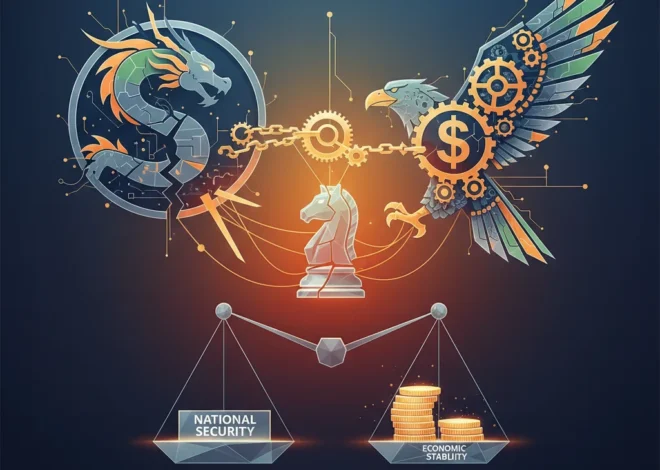
High-Stakes Showdown: Canada Draws a Line in the Sand with Jeep-Maker Stellantis
In the high-stakes world of global manufacturing, the movement of a single production line can trigger economic shockwaves, pitting multinational corporations against national governments. A recent flare-up between Canada and automotive giant Stellantis, the parent company of Jeep, Chrysler, and Ram, serves as a potent case study in this modern industrial drama. The core of the dispute, as reported by the BBC, is Stellantis’s proposed plan to shift production of its popular Jeep Compass model from its plant in Brampton, Ontario, to a facility in Belvidere, Illinois. This isn’t just a simple logistical shuffle; it’s a move that strikes at the heart of Canada’s automotive sector, testing the limits of government influence and corporate strategy in an era of fierce competition for electric vehicle (EV) investments.
For investors, business leaders, and anyone following the intricacies of the global economy, this standoff is more than just a headline. It’s a microcosm of the larger forces at play: the seismic shift to EVs, the resurgence of protectionist industrial policy, and the delicate dance of labor negotiations. Understanding the dynamics of this conflict offers critical insights into the future of manufacturing, the stability of supply chains, and the evolving relationship between capital and country.
The Players and the Prize: Unpacking the Conflict
To grasp the gravity of the situation, it’s essential to understand the key players and what’s at stake. On one side is Stellantis, a global automotive behemoth forged from the merger of Fiat Chrysler Automobiles and France’s PSA Group. For Stellantis, the decision is driven by a complex calculus of logistics, labor costs, and long-term strategic planning, particularly its multi-billion-dollar pivot to electric vehicles. Corporate finance departments at this scale utilize sophisticated financial technology and modeling to weigh every variable, from shipping costs to tax incentives, in a relentless pursuit of efficiency and profitability.
On the other side is the Canadian government, represented by its vocal Industry Minister, François-Philippe Champagne. For Canada, the potential loss of the Jeep Compass line is a significant blow. The automotive industry is a cornerstone of the Ontario provincial economy, supporting hundreds of thousands of jobs directly and indirectly. The government has invested heavily in securing its place in the future of EV manufacturing, offering massive subsidies to companies like Volkswagen and Stellantis itself for new battery plants. Losing an existing production line, even for a traditional internal combustion engine (ICE) vehicle, is seen as a breach of faith and a threat to the country’s industrial base.
The situation is further complicated by the recent, hard-fought labor agreements between Stellantis and the auto unions in both countries—Unifor in Canada and the United Auto Workers (UAW) in the United States. As part of its landmark 2023 agreement with the UAW, Stellantis committed to reopening its idled plant in Belvidere, Illinois, to build a new mid-size truck and invest in a new parts distribution center and battery plant, creating over 1,000 jobs. This commitment, celebrated as a major win for American labor, now appears to be on a collision course with the company’s existing operations in Canada.
Below is a breakdown of the primary stakes for each major party involved in this dispute:
| Stakeholder | Primary Motivation | Key Leverage |
|---|---|---|
| Stellantis (Jeep-Maker) | Operational efficiency, profitability, fulfilling UAW commitments, and executing its EV transition strategy. | Ability to allocate production and capital investment globally. |
| Canadian Government | Job retention, protecting its industrial base, and ensuring a return on its significant public investments (subsidies). | Financial incentives, regulatory hurdles, and potential “consequences” (tariffs, clawbacks). |
| Unifor (Canadian Union) | Protecting the jobs and future of the Brampton, Ontario plant workers. | Labor action (strikes) and political pressure. |
| Investors & the Stock Market | Long-term profitability, stable operations, and clear strategic direction from Stellantis (STLA). | Capital allocation and stock trading activity, which reflects confidence in management. |
The Quiet Bull Run: Why Institutional Investors Are Doubling Down on Ethereum
The EV Revolution and the Subsidy Wars
This conflict cannot be viewed in isolation. It is a direct consequence of the global race to dominate the electric vehicle market. Governments worldwide are rolling out the red carpet for automakers, offering billions in subsidies, tax credits, and grants to secure battery plants and EV assembly lines. The United States’ Inflation Reduction Act (IRA) has been a particularly powerful magnet, pulling investment south of the Canadian border with its generous consumer and manufacturing credits for North American-made EVs and batteries.
Canada has responded aggressively to avoid being left behind. In 2023, the federal and Ontario governments committed up to C$13 billion in performance incentives for a Volkswagen battery cell plant and up to C$15 billion for a similar Stellantis-LG Energy Solution facility. These deals were explicitly designed to level the playing field with the US IRA. From Canada’s perspective, having made such a monumental financial commitment, the notion that Stellantis would simultaneously subtract a key production line is untenable. Minister Champagne’s warning of “consequences” is a clear signal that Canada is prepared to use the leverage from these massive subsidy packages to enforce its expectations.
This highlights a critical lesson in modern economics: industrial policy is back. The laissez-faire approach of previous decades is being replaced by active government intervention aimed at building resilient domestic supply chains, particularly in strategic sectors like automotive and green technology. For companies, this means navigating a complex web of political expectations alongside traditional market forces. The best location for a plant is no longer just an economic calculation but a geopolitical one as well.
Implications for Finance and Investing
For those engaged in investing and watching the stock market, this dispute serves as a crucial risk indicator. The stock price of a company like Stellantis (STLA) is sensitive to operational disruptions, political instability, and unforeseen costs. A prolonged fight with the Canadian government could lead to several negative outcomes:
- Regulatory Risk: Canada could impose new regulations, delay permits for other projects, or even attempt to claw back portions of its promised subsidies, directly impacting the company’s bottom line.
- Reputational Damage: Being seen as a company that takes government money while cutting local jobs can harm brand perception among consumers and policymakers, a significant intangible asset.
- Supply Chain Disruption: While moving one line may seem straightforward, it can have ripple effects throughout the North American supply chain, affecting hundreds of smaller parts suppliers and logistics providers. The complex systems of modern banking and fintech that facilitate supply chain finance could be strained by such uncertainty.
This situation underscores the growing importance of incorporating geopolitical and policy analysis into any investment thesis for the manufacturing sector. An investor cannot simply look at a company’s balance sheet; they must also assess its relationship with the governments in the jurisdictions where it operates. The ability to successfully navigate the political landscape is becoming as important as engineering excellence or marketing prowess.
Furthermore, the incident raises broader questions about the long-term sustainability of the subsidy-driven model for attracting investment. While these incentives are powerful, they create a dependency and a set of political strings that can constrain a company’s flexibility. What happens when the subsidies run out, or when a different jurisdiction offers a better deal? The current environment fosters a “race to the bottom” where governments continuously outbid each other, a trend that may not be sustainable for public finances. According to a study by the Fraser Institute, business subsidies in Canada have been a long-standing practice, but the scale seen in the EV sector is unprecedented, raising the stakes for both sides.
The Road Ahead: A Negotiated Peace or an Economic War?
The standoff between Canada and Stellantis is unlikely to be resolved overnight. It is a negotiation playing out in public, with both sides using the media to signal their resolve. Stellantis is trying to optimize its massive North American manufacturing footprint for the EV era, a painful but necessary process of creative destruction. Canada is fighting to protect its economic sovereignty and ensure that it remains a key player in the auto industry of the future, not just a historical footnote.
The resolution will likely involve a compromise. Stellantis may need to offer a new product mandate for the Brampton plant to appease the Canadian government and Unifor. This could involve retooling the plant for a new hybrid or fully electric vehicle, which would align with Canada’s long-term goals. In return, Canada would ensure the smooth rollout of the subsidies for the massive battery plant in Windsor, a project far more critical to Stellantis’s future than the Compass production line. As detailed in their initial investment announcement, the partnership is meant to be a cornerstone of Canada’s EV ecosystem.
Ultimately, this conflict is a powerful reminder that in the 21st-century global economy, business decisions are never just about business. They are deeply intertwined with national politics, labor relations, and the powerful currents of technological change. For investors, executives, and policymakers, the road ahead requires a sophisticated understanding of this complex interplay. The roar of the engine at the Brampton plant may depend less on engineers and more on the diplomats and negotiators working behind the scenes.
Strategic Deployment: What a National Guard Presence in Chicago Teaches Us About Financial Fortitude
Watching how this unfolds will provide a clear blueprint for how other multinational corporations and governments will likely handle similar disputes in the coming years as the EV transition accelerates, reshaping the industrial map of North America and the world.


